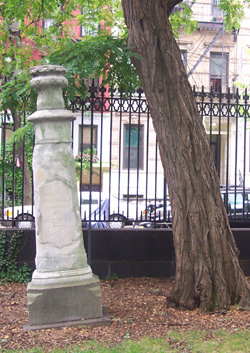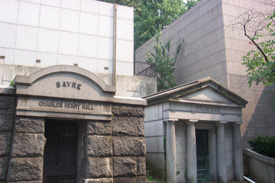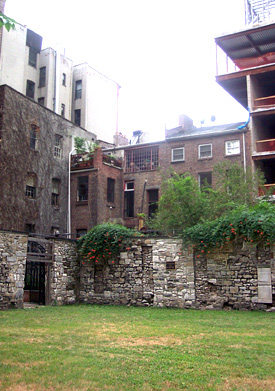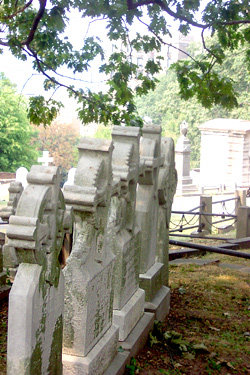|
|
Following his death on July 4, 1831, and a glorious funeral procession through the streets of New York watched by as many as a hundred thousand people, United States President James Monroe became one of the first people to be buried in the brand new New York City Marble Cemetery on the Lower East Side, then a leafy, bucolic suburb on the northern fringe of New York City.
Thirty years later, Virginians reclaimed their native son, deeming the cemetery an insufficiently dignified place. By that time, the area was becoming the city's most crowded slum, and those from the fairer classes, living or dead, were fleeing.
The New York City Marble Cemetery still stands, on East 2nd Street, across from the Anthology Film Archives, near Urge bar and Anyway Cafe.
It might seem to have changed far less than the neighborhood around it, but in truth there are many parallels between the city's residences for the living and those for the dead. In Manhattan, burial space is even harder to find than an apartment. There is only one truly active graveyard in Manhattan - Trinity Church's cemetery in Washington Heights – and even there the only available space is in above ground "community mausoleums", large marble blocks that are, essentially, condos for corpses. Unhindered by rent regulations, the prices for graves have continued to rise. This has driven some who have spent a lifetime resisting the pull of the suburbs to wind up there posthumously.
Close to 325 graveyards have existed at some point during the city's history, according to Graveyard Shift: The Family Historian's Guide to New York City Cemeteries. Of these, the New York State Division of Cemeteries estimates that 75 are still accepting newcomers, mostly in Brooklyn or Queens. There is no reliable estimate for how many people get buried here each year, but given that the two largest cemeteries in the city -- Brooklyn's Green-Wood and Woodlawn in the Bronx -- bury only 3,000 people combined, there is little doubt that many of the 60,000 or so city residents that die annually end up beyond the city limits.
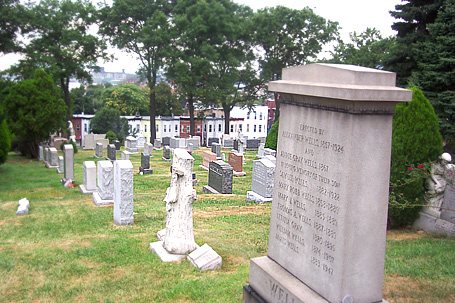
Green-Wood Cemetery
Still, city cemeteries are concerned that they will soon run out of space. When a graveyard fills up, it loses its primary means of income. Many fall into disrepair; some are abandoned completely. Many New Yorkers see cemeteries as not only places to bury the dead, but also as important green spaces and historical relics, and there are increasing efforts to preserve cemeteries or restore those in need.
For their part, all cemeteries are setting money aside to prepare for the day when they run out of space. Some are also looking for other ways to raise the money they need to mow their lawns and maintain their tombstones in perpetuity.
"When your entire annual budget is spent on a few hours gardening and general maintenance, you want to think creatively," said Colleen Iverson of the New York City Marble Cemetery. The cemetery, like others, solicits donations by promoting itself as a historical site through events like Open House New York (this year, four cemeteries are participating: New York City Marble Cemetery, nearby New York Marble Cemetery, Green-Wood and Woodlawn). Cemeteries are also encouraging engagement by throwing concerts (there is a concert this Thursday at the New York City Marble Cemetery), leading regular tours, holding cocktail parties, and even offering themselves out for weddings.
 Forty years ago, New York reacted to the loss of old Pennsylvania Station by passing a law to protect city landmarks. This series, in partnership with Open House New York, looks at the physical city since the birth of the preservation movement. |
New York City Marble Cemetery has also decided to give burying people another try. The cemetery has held two funerals in the last five years, and is now trying to let people know that there is some room left yet. But if the recent funerals have presented potential for the cemetery, they have also reminded it of its vulnerability. In November 2000, over 150 years after Monroe was buried there, the cemetery held another military funeral. Twenty-five people gathered and listened as two soldiers played taps. At the moment that the trumpets hit their last note, a large section of the cemetery's wall collapsed.
RUNNING OUT OF ROOM
Nationwide, there is no danger of cemeteries running out of room, according to Bob Fells of the International Cemetery and Funeral Association. More people are choosing to get cremated - about 28 percent of Americans who died in 2002 were cremated, as opposed to 7.6 percent 25 years earlier. Cemeteries have developed more efficient ways to bury everyone else, like "stacking" more than one coffin in a single gravesite, and more people are being buried in above ground community mausoleums. Some cemeteries are even selling or leasing land that they don't need. Places like Long Island's Pinelawn Cemetery, home to many former New Yorkers, has so much extra space that it has built a 27-hole golf course on land it originally intended to use for burials.
But for many New York cemeteries it's a different story. The problem is most dire at Catholic and Jewish graveyards, said Richard Moylan, head of the Metropolitan Cemetery Association and president of Green-Wood. But even 478-acre Green-Wood, the city's largest cemetery, is feeling squeezed. Green-Wood buries about 1,500 people a year, and only has enough room to do so for about five more years. It has long been closing roads and rethinking its layout to make more room for gravesites.
As space in cemeteries gets scarcer, its price rises. In 1882, legendary Wall Street speculator Jay Gould bought a 30,000 square foot plot of land at Woodlawn for his family mausoleum at $2 a square foot, an exorbitant price at the time. The same plot today, instead of costing $60,000, would cost $6 million. A typical (far smaller) gravesite at Woodlawn costs $4,400, even as the cemetery insists it still has plenty of room. At Green-wood, plots start at $7,000.
|
|
The problem of scarcity is unlikely to be solved by cemeteries acquiring land. Acquiring real estate in New York City is difficult for anyone, and there are strict regulations for cemeteries buying land to bury people in. Because this land comes off the tax rolls, there is little incentive for governments to approve such conversions even if cemeteries could afford to try.
"It's pretty well status quo," said Rich Fishman, head of the state's Division of Cemeteries.
What the state has done recently is make it easier for cemeteries to use their own land more efficiently. Some cemeteries have a significant amount of unused land that was purchased by people who the cemeteries have since lost contact with. Lawmakers in Albany recently passed a measure that would allow cemeteries to reclaim such land after 75 years have passed without word from the owners.
Many of the empty graves were bought some 80 years ago, when rumors of limited grave space led people to hoard plots for future burials or resale, making them eligible for reclamation. The state and the Metropolitan Cemetery Association see this as a way to provide some immediate relief to some cemeteries where space is a concern.
Not having the money for continued maintenance is a serious concern for aging cemeteries. In the past some have disappeared below new development, a fate that theoretically won't happen now because the restrictions for new development on cemetery land are even tougher than those keeping cemeteries from developing new land. But the threat of falling into disrepair or abandonment is real, say some who manage historic cemeteries in the city. To avoid this, they are looking beyond burials to other fundraising possibilities.
GRAVEYARDS OR GREENSPACES?
Richard Moylan began cutting the grass at Green-Wood in 1972 as a summer job the year he finished high school. At the time being bereaved was the price of entry for those who didn't work there. Anyone approaching the cemetery's gates intending to take a stroll through its grounds or get a glimpse of its stunning view of Manhattan's skyline was turned away.
"We did not encourage the public to enter," said Moylan. "It was basically lot owners and families."
The cemetery closed its gates because it was frightened of vandalism and a bit ashamed of its unkempt state. With its own problems to consider, the cemetery didn't think much about its interaction with the public. Its financial struggles turned into young Moylan's own; he was laid off when he came back to work in the summer of 1973.
But eventually Green-Wood decided it couldn't pretend it was just a graveyard. It was an enormous park in the center of Brooklyn, and a historical resource as well. There were former mayors, deceased gangsters and Boss Tweed, a member of both categories. Charles Ebbets of Ebbets Field was buried there, as was Horace Greeley, the editor of the New York Tribune. The city had even declared that the gates that kept people out were a landmark. In the early 1990s the cemetery opened those gates, and it now plays host to about 300,000 visitors a year.
Green-Wood isn't the only cemetery whose appeal stretches beyond those whose loved ones are buried there. The city has designated so many cemeteries as landmarks that a spokesperson for the Landmarks Preservation Commission declined to even guess at the total number. It is a distinction that, while it does not involve any direct funding, can make it easier for cemeteries looking for grant money or private donations.
|
|
And increasingly they are looking. They are organizing tours and other events aimed at seducing history buffs into helping out. A music teacher from Brooklyn gave Green-Wood $5,000 to restore a monument to William Wheatley, who has been credited with creating the American musical; Woodlawn is currently hoping a generous musician will do the same for Augustus D. Juilliard's grave.
The potential historic significance of some cemeteries is made clear by a drive through Woodlawn with Susan Olsen, the cemetery's cheery historian with an "I brake for historic graveyards" bumper sticker on the back of her car. She points out the tombs of Robert Moses (in the corner of the cemetery directly adjacent to the entrance to the Major Deegan Expressway); Fiorello LaGuardia and four other mayors (none of whose tombstones have the word "mayor" on them); "Moby Dick" author Herman Melville ("every failed writer comes to pay tribute to poor old Melville"); and the adjacent resting places of Duke Ellington and Miles Davis, the cemetery's most popular spot.
A new addition is salsa queen Celia Cruz, and the cemetery recently learned that Colin Powell made annual visits to pay respects to members of his family - when the Bronx native mentioned the trips at a dedication ceremony at the World War II memorial in Washington DC. Contrary to popular belief, however, Bronx rapper Big Pun is not buried here - his remains were returned to his family after his cremation in the Woodlawn crematorium.
Such a rich history is a valuable resource, says Olsen, and the cemetery is often playing host to a historic researcher or two digging through the archives. But Woodlawn does try to keep this function separate from its primary purpose. Olsen's office is located about as far away from the main office as one can get without ending up on Jerome Avenue.
"What we try to do is keep our happy history stuff separate from our regular business," said Olsen. "People who are doing genealogy are all excited about researching Miles Davis; you don't want them to be in a situation where they're working next to someone burying a loved one."
There is definitely a line that can be crossed - Green-Wood's movie series, which included a run of horror movies, inspired complaints by some who were visiting to mourn. The cemetery decided to cancel the movies. But being close to capacity, Green-Wood is trying to cultivate its role as a public space more aggressively than Woodlawn. "Our end isn't imminent, but it's coming," said Moylan. "And to start thinking about it when you're out of space is too late."
BRINGING A CEMETERY BACK FROM THE DEAD
|
|
Cate Ludlam was introduced to Prospect Cemetery in 1989, when she got a telephone call from a woman who had entered what she thought was a dump to save some puppies. The woman had found hundreds of tombstones, some with the name "Ludlam" on them, and looked Cate up in the phone book.
The woman had stumbled onto the oldest cemetery in Queens, established in 1668. It had been effectively abandoned for years; there were records as far back as 1910 describing the cemetery as so overgrown that it was impassible, about 50 years after one of Ludlam's ancestors commissioned a chapel to be built there. Ludlum was shocked to find that the tombstones and chapel had been badly damaged.
"When I saw the chapel, when I saw the destruction, I wept," she said. "You couldn't do anything but weep. I've never seen something so lovely vandalized that badly."
New York State tries to ensure that cemeteries do not allow themselves to fall into such a state of disrepair. State law calls for a portion of burial costs to be set aside in a trust which, in theory, is supposed to sustain cemeteries in perpetuity.
This had not worked for Prospect Cemetery. It had some funding and was being run by a board of trustees when Ludlam discovered it. But the board's management style was minimal to say the least: its director, the wife of a man who was buried there, was herself in her late eighties. She lived out of state.
Ludlam formed a new board with several other descendants who had also been contacted by the puppy saver. They had access to about $1,500 a year - and an enormous task ahead of them.
Immediately, Ludlam enlisted the help of the Greater Jamaica Development Corporation. As most of the other board members drifted off she also recruited the New York Landmarks Conservancy. With their help repaired the fence to prevent vandalism, and has arranged for volunteer workers come several times a year to help landscape. The cemetery is still closed to the public, but Ludlam is eager to lead tours for those who request it.
Through continued use of endowments and a slow stream of donations, the cemetery is nearing the point where it will have enough money to fix up the chapel that made Ludlam cry 15 years ago. A congregation has inquired about renting it one day a week, and she hopes that it will also serve as a small museum and a place to hold events that will bring in other funds as well.
"What looks like a snail's pace is really progress," said Ludlam of the restoration. "We may be able to do the chapel this year. This is really a miracle - for me at least."
Â
